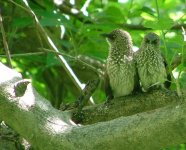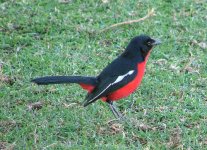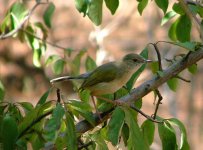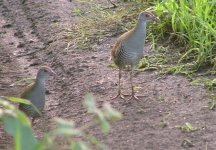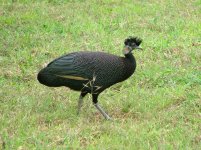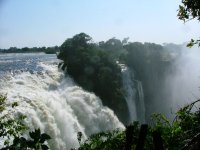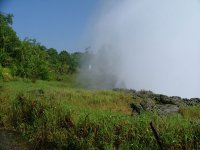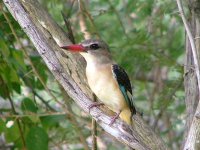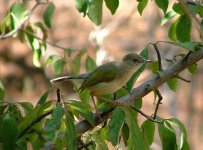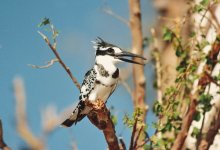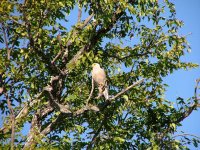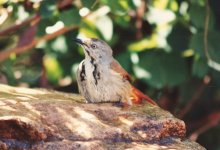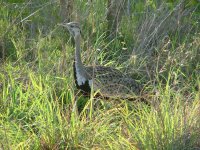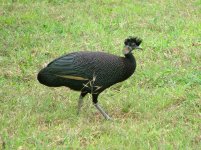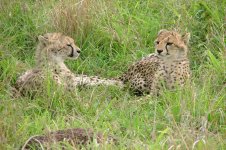My wife and I are off birding next week in South Africa. We're heading to Kruger via Seringveld.
We're stopping a couple of nights in Punda Maria rest camp, before heading further south in the park.
Would appreciate key target birds at Punda Maria, if that's not to much to ask for.
Will be pleased to feed back on what we spot at each location.
Thanks
Dave Hunter
Will feed back
Dave, Hi,
This is the list of good Punda Maria birds as taken from the website below. Punda is unique in Kruger in that there is an area of sand forest with its own particular birds which are unlikely to occur elswwhere in the park.
"Punda Maria
Punda Maria is the northernmost camp in the Park, and is situated on a ridge amongst some rolling hills. It is a good base for the northern areas from Shingwidzi to Pafuri, and provides access to a number of productive habitats and special birds.
The camp itself is small but charming, and the fenced area is quite large, with an area of natural bush on the ridge above the camp. The birdbath just below the picnic site in front of the chalets is always productive; White-throated Robin-Chat, Bearded Scrub-Robin, Green-winged Pytilia, Purple-crested Turaco, Terrestrial Brownbul, Violet-backed Starling, Blue Waxbill, Cut-throat Finch, Jameson's Firefinch, Bearded Woodpecker, Greater Blue-eared Starling and Red-headed Weaver are amongst the visitors. The trail up the ridge behind the camp is worth exploring for Grey-headed Bush-Shrike and Orange-breasted Bush-Shrike, Eastern Nicator and Bearded Scrub-Robin. The campsite is rather bare but may turn up Dusky Lark, Golden-breasted Bunting, Grey Penduline-Tit, Yellow-bellied Greenbul and Burchell's Starling. At night, listen out for African Scops-Owl, African Barred Owlet, Barn Owl, Verreaux's Eagle-Owl, Spotted Eagle-Owl and Southern White-faced Scops-Owl, as well as Fiery-necked Nightjar and Square-tailed Nightjar. Pennant-winged Nightjar has also been recorded in summer.
The Mahone Loop (S99) is an excellent 28km circuit for a mornings birding. The road passes through some dense mixed woodland on red sandy soils. Driving anti-clockwise, you first pass through some mixed mopane woodland. The best 'sandveld' woodland is in the region of Matukwale dam on the western side of the loop. Here you should look out for Gorgeous Bush-Shrike, White-breasted Cuckooshrike, Narina Trogon, Eastern Nicator, Thick-billed Cuckoo, Broad-billed Roller, Mosque Swallow, Grey-headed Parrot and Grey-headed Kingfisher. The rare Racket-tailed Roller has been recorded from Mopane woodland on this loop, and the few Burkea africana trees have attracted Southern Hyliota. African Crowned Eagle breed near the dam, African Hawk-Eagle have a number of nest sites along the ridge on the southern side of the loop, and Bateleur breed near the waterhole 3km from the tar road.
During the heat of the day, and especially when a southerly wind blows, large raptors use the ridge above the camp for uplift. These include White-backed Vulture and Lappet-faced Vulture, Martial Eagle, Tawny Eagle, African Hawk-Eagle, Brown Snake-Eagle, African Harrier-Hawk, Lanner Falcon and African Goshawk all year round, and in summer, Wahlberg's Eagle, Steppe Eagle, Lesser Spotted Eagle, Steppe Buzzard, Yellowbilled kite, Black Kite and Eurasian Hobby.
From Punda Maria take the tar road H13-2 towards the junction with the H13-1.There is some worthwhile birding along here, including African Cuckoo, Grey-headed Parrot and Mosque Swallow. The road passes over a culvert that is used for breeding by White-rumped Swift, Little Swift and Lesser Striped Swallow. Shortly thereafter turn left onto the S60 towards Pafuri. The road runs along the side of a ridge of hills and passes through some mature Mopane woodland. Look out for Eurasian Golden Oriole, African Golden Oriole, Racket-tailed Roller, Purple Roller, Arnot's Chat, Bearded Woodpecker, Bennett's Woodpecker, Arnot's Chat and Stierling's Wren-Warbler.
Continue to the tar via the S59, S60 or S61. The more open habitat here is suitable for Black-bellied Bustard, Kori Bustard and Southern Ground-Hornbill, and if lucky, Dickinson's Kestrel. In spring, burnt areas will have Temminck's Courser, while in late summer Harlequin Quail, African Crake and Corn Crake should be looked for in rank grass. Klopperfontein Dam can be checked for Comb Duck, African Jacana and possibly Lesser Moorhen.
At the tar head south to the intersection with the H13 back to Punda Maria. Look out for Tawny Eagle and Black-chested Snake-Eagle, and in summer, Montagu's Harrier. Continue past the Punda Maria turnoff (towards Shingwidzi) and stop at an area of palm savanna. In late summer this should be checked for Black Coucal, African Crake and Croaking Cisticola and Rufous-winged Cisticola. A little further on turn right onto the S58 where the road crosses a stream and passes through some wet areas after good summer rains. These should be checked for Little Bittern, Dwarf Bittern, Lesser Moorhen and Allen's Gallinule. Head back to Punda Maria through the tall Mopane woodland on the H13-1, and check carefully for Arnot's Chat, especially on the north side about 500 m before exiting the woodland. "
http://www.sabirding.co.za/birdspot/060909.asp
I would also suggest that you try, if you have time, to get up to Pafuri, a reasonable drive to the north, which also has some special birds.
Here are the birds that I would consider an achievement in these areas.....
Pafuri
Mottled Spinetail, Böhm's Spinetail, Gorgeous Bush-Shrike, Pel's Fishing-Owl, Black-throated Wattle-eye, Three-banded Courser, Thrush Nightingale
*Note* Mottled spinetails can often be seen where the road to Pafuri gate crosses the Luvuvhu River.
Punda Maria
Pennant-winged Nightjar, Narina Trogon, Thick-billed Cuckoo, Mosque Swallow, Grey-headed Parrot, Racket-tailed Roller, Southern Hyliota, Lesser Spotted Eagle, Eurasian Hobby, Arnot's Chat, Dickinson's Kestrel, Lesser Moorhen, Montagu's Harrier, Dwarf Bittern, Allen’s Gallinule
*Note* 1) The Mahonie Loop takes you round the Sand Forest 2) Arnot's Chat like stands of TALL mopane trees
And I’ll let you into a secret……..in a previous visit to Punda Maria I saw a Black-fronted Bush-shrike. Now that would really be a find!
I will look forward to hearing about what you have seen.
Hope this helps
Dave Kennedy




